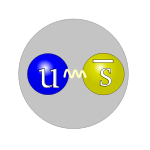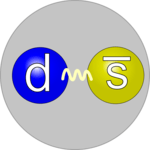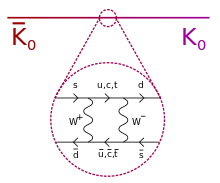Kaon
In particle physics, a kaon /ˈkeɪ.ɒn/, also called a K meson and denoted
K
,[lower-alpha 1] is any of a group of four mesons distinguished by a quantum number called strangeness. In the quark model they are understood to be bound states of a strange quark (or antiquark) and an up or down antiquark (or quark).
| Composition | K+ : u s
K− : s u |
|---|---|
| Statistics | Bosonic |
| Interactions | Strong, weak, electromagnetic, gravitational |
| Symbol | K+ , K0 , K− |
| Discovered | 1947 |
| Types | 4 |
| Mass | K± : 493.677±0.013 MeV/c2 K0 : 497.648±0.022 MeV/c2 |
| Electric charge | K± : ±1 e K0 : 0 e |
| Spin | 0 |
| Strangeness | K+ : +1
K− : -1 |

K+
) into three pions (2
π+
, 1
π−
) is a process that involves both weak and strong interactions.
Weak interactions : The strange antiquark (
s
) of the kaon transmutes into an up antiquark (
u
) by the emission of a
W+
boson; the
W+
boson subsequently decays into a down antiquark (
d
) and an up quark (
u
).
Strong interactions: An up quark (
u
) emits a gluon (
g
) which decays into a down quark (
d
) and a down antiquark (
d
).
Kaons have proved to be a copious source of information on the nature of fundamental interactions since their discovery in cosmic rays in 1947. They were essential in establishing the foundations of the Standard Model of particle physics, such as the quark model of hadrons and the theory of quark mixing (the latter was acknowledged by a Nobel Prize in Physics in 2008). Kaons have played a distinguished role in our understanding of fundamental conservation laws: CP violation, a phenomenon generating the observed matter–antimatter asymmetry of the universe, was discovered in the kaon system in 1964 (which was acknowledged by a Nobel Prize in 1980). Moreover, direct CP violation was discovered in the kaon decays in the early 2000s by the NA48 experiment at CERN and the KTeV experiment at Fermilab.
Basic properties
The four kaons are :
K−
, negatively charged (containing a strange quark and an up antiquark) has mass 493.677±0.013 MeV and mean lifetime (1.2380±0.0020)×10−8 s.
K+
(antiparticle of above) positively charged (containing an up quark and a strange antiquark) must (by CPT invariance) have mass and lifetime equal to that of
K−
. Experimentally, the mass difference is 0.032±0.090 MeV, consistent with zero; the difference in lifetimes is (0.11±0.09)×10−8 s, also consistent with zero.
K0
, neutrally charged (containing a down quark and a strange antiquark) has mass 497.648±0.022 MeV. It has mean squared charge radius of −0.076±0.01 fm2.
K0
, neutrally charged (antiparticle of above) (containing a strange quark and a down antiquark) has the same mass.
As the quark model shows, assignments that the kaons form two doublets of isospin; that is, they belong to the fundamental representation of SU(2) called the 2. One doublet of strangeness +1 contains the
K+
and the
K0
. The antiparticles form the other doublet (of strangeness −1).
| Particle name | Particle symbol |
Antiparticle symbol |
Quark content |
Rest mass (MeV/c2) | IG | JPC | S | C | B' | Mean lifetime (s) | Commonly decays to (>5% of decays) |
|---|---|---|---|---|---|---|---|---|---|---|---|
| Kaon[1] | K+ |
K− |
u s |
493.677±0.016 | 1⁄2 | 0− | 1 | 0 | 0 | (1.2380±0.0021)×10−8 | μ+ + ν μ or π+ + π0 or π+ + π+ + π− or π0 + e+ + ν e |
| Kaon[2] | K0 |
K0 |
d s |
497.611±0.013 | 1⁄2 | 0− | 1 | 0 | 0 | [§] | [§] |
| K-Short[3] | K0 S |
Self | [†] | 497.611±0.013[‡] | 1⁄2 | 0− | [⁎] | 0 | 0 | (8.954±0.004)×10−11 | π+ + π− or π0 + π0 |
| K-Long[4] | K0 L |
Self | [†] | 497.611±0.013[‡] | 1⁄2 | 0− | [⁎] | 0 | 0 | (5.116±0.021)×10−8 | π± + e∓ + ν e or π± + μ∓ + ν μ or π0 + π0 + π0 or π+ + π0 + π− |

[⁎] See Notes on neutral kaons in the article List of mesons, and neutral kaon mixing, below.
[§]^ Strong eigenstate. No definite lifetime (see neutral kaon mixing).
[†]^ Weak eigenstate. Makeup is missing small CP–violating term (see neutral kaon mixing).
[‡]^ The mass of the
K0
L and
K0
S are given as that of the
K0
. However, it is known that a relatively minute difference between the masses of the
K0
L and
K0
S on the order of 3.5×10−6 eV/c2 exists.[4]
Although the
K0
and its antiparticle
K0
are usually produced via the strong force, they decay weakly. Thus, once created the two are better thought of as superpositions of two weak eigenstates which have vastly different lifetimes:
- The long-lived neutral kaon is called the
K
L ("K-long"), decays primarily into three pions, and has a mean lifetime of 5.18×10−8 s.
- The short-lived neutral kaon is called the
K
S ("K-short"), decays primarily into two pions, and has a mean lifetime 8.958×10−11 s. Quark structure of the kaon minus (K⁻).
Quark structure of the kaon minus (K⁻).
(See discussion of neutral kaon mixing below.)
An experimental observation made in 1964 that K-longs rarely decay into two pions was the discovery of CP violation (see below).
Main decay modes for
K+
:
 Quark structure of the neutral kaon (K⁰).
Quark structure of the neutral kaon (K⁰).
| Results | Mode | Branching ratio |
|---|---|---|
μ+ ν μ |
leptonic | 63.55±0.11% |
π+ π0 |
hadronic | 20.66±0.08% |
π+ π+ π− |
hadronic | 5.59±0.04% |
π+ π0 π0 |
hadronic | 1.761±0.022% |
π0 e+ ν e |
semileptonic | 5.07±0.04% |
π0 μ+ ν μ |
semileptonic | 3.353±0.034% |
Decay modes for the
K−
are charge conjugates of the ones above.
Strangeness
The discovery of hadrons with the internal quantum number "strangeness" marks the beginning of a most exciting epoch in particle physics that even now, fifty years later, has not yet found its conclusion ... by and large experiments have driven the development, and that major discoveries came unexpectedly or even against expectations expressed by theorists. — I.I. Bigi and A.I. Sanda, CP violation, (ISBN 0-521-44349-0)
In 1947, G. D. Rochester and Clifford Charles Butler of the University of Manchester published two cloud chamber photographs of cosmic ray-induced events, one showing what appeared to be a neutral particle decaying into two charged pions, and one which appeared to be a charged particle decaying into a charged pion and something neutral. The estimated mass of the new particles was very rough, about half a proton's mass. More examples of these "V-particles" were slow in coming.
The first breakthrough was obtained at Caltech, where a cloud chamber was taken up Mount Wilson, for greater cosmic ray exposure. In 1950, 30 charged and 4 neutral V-particles were reported. Inspired by this, numerous mountaintop observations were made over the next several years, and by 1953, the following terminology was adopted: "L-meson" meant muon or pion. "K meson" meant a particle intermediate in mass between the pion and nucleon. "Hyperon" meant any particle heavier than a nucleon.
The decays were extremely slow; typical lifetimes are of the order of 10−10 s. However, production in pion-proton reactions proceeds much faster, with a time scale of 10−23 s. The problem of this mismatch was solved by Abraham Pais who postulated the new quantum number called "strangeness" which is conserved in strong interactions but violated by the weak interactions. Strange particles appear copiously due to "associated production" of a strange and an antistrange particle together. It was soon shown that this could not be a multiplicative quantum number, because that would allow reactions which were never seen in the new synchrotrons which were commissioned in Brookhaven National Laboratory in 1953 and in the Lawrence Berkeley Laboratory in 1955.
Parity violation
Two different decays were found for charged strange mesons:
Θ+→
π+
+
π0
τ+→
π+
+
π+
+
π−
The intrinsic parity of a pion is P = −1, and parity is a multiplicative quantum number. Therefore, the two final states have different parity (P = +1 and P = −1, respectively). It was thought that the initial states should also have different parities, and hence be two distinct particles. However, with increasingly precise measurements, no difference was found between the masses and lifetimes of each, respectively, indicating that they are the same particle. This was known as the τ–θ puzzle. It was resolved only by the discovery of parity violation in weak interactions. Since the mesons decay through weak interactions, parity is not conserved, and the two decays are actually decays of the same particle,[5] now called the
K+
.
CP violation in neutral meson oscillations
Initially it was thought that although parity was violated, CP (charge parity) symmetry was conserved. In order to understand the discovery of CP violation, it is necessary to understand the mixing of neutral kaons; this phenomenon does not require CP violation, but it is the context in which CP violation was first observed.
Neutral kaon mixing

K0
turns into a down quark by successively absorbing two W-bosons of opposite charge. The down antiquark in the anti-
K0
turns into a strange antiquark by emitting them.
Since neutral kaons carry strangeness, they cannot be their own antiparticles. There must be then two different neutral kaons, differing by two units of strangeness. The question was then how to establish the presence of these two mesons. The solution used a phenomenon called neutral particle oscillations, by which these two kinds of mesons can turn from one into another through the weak interactions, which cause them to decay into pions (see the adjacent figure).
These oscillations were first investigated by Murray Gell-Mann and Abraham Pais together. They considered the CP-invariant time evolution of states with opposite strangeness. In matrix notation one can write
where ψ is a quantum state of the system specified by the amplitudes of being in each of the two basis states (which are a and b at time t = 0). The diagonal elements (M) of the Hamiltonian are due to strong interaction physics which conserves strangeness. The two diagonal elements must be equal, since the particle and antiparticle have equal masses in the absence of the weak interactions. The off-diagonal elements, which mix opposite strangeness particles, are due to weak interactions; CP symmetry requires them to be real.
The consequence of the matrix H being real is that the probabilities of the two states will forever oscillate back and forth. However, if any part of the matrix were imaginary, as is forbidden by CP symmetry, then part of the combination will diminish over time. The diminishing part can be either one component (a) or the other (b), or a mixture of the two.
Mixing
The eigenstates are obtained by diagonalizing this matrix. This gives new eigenvectors, which we can call K1 which is the sum of the two states of opposite strangeness, and K2, which is the difference. The two are eigenstates of CP with opposite eigenvalues; K1 has CP = +1, and K2 has CP = −1 Since the two-pion final state also has CP = +1, only the K1 can decay this way. The K2 must decay into three pions. Since the mass of K2 is just a little larger than the sum of the masses of three pions, this decay proceeds very slowly, about 600 times slower than the decay of K1 into two pions. These two different modes of decay were observed by Leon Lederman and his coworkers in 1956, establishing the existence of the two weak eigenstates (states with definite lifetimes under decays via the weak force) of the neutral kaons.
These two weak eigenstates are called the
K
L (K-long) and
K
S (K-short). CP symmetry, which was assumed at the time, implies that
K
S = K1 and
K
L = K2.
Oscillation
An initially pure beam of
K0
will turn into its antiparticle,
K0
, while propagating, which will turn back into the original particle,
K0
, and so on. This is called particle oscillation. On observing the weak decay into leptons, it was found that a
K0
always decayed into a positron, whereas the antiparticle
K0
decayed into the electron. The earlier analysis yielded a relation between the rate of electron and positron production from sources of pure
K0
and its antiparticle
K0
. Analysis of the time dependence of this semileptonic decay showed the phenomenon of oscillation, and allowed the extraction of the mass splitting between the
K
S and
K
L. Since this is due to weak interactions it is very small, 10−15 times the mass of each state, namely ∆MK=M(KL)−M(KS)=3.484(6)×10−12 MeV.[6]
Regeneration
A beam of neutral kaons decays in flight so that the short-lived
K
S disappears, leaving a beam of pure long-lived
K
L. If this beam is shot into matter, then the
K0
and its antiparticle
K0
interact differently with the nuclei. The
K0
undergoes quasi-elastic scattering with nucleons, whereas its antiparticle can create hyperons. Due to the different interactions of the two components, quantum coherence between the two particles is lost. The emerging beam then contains different linear superpositions of the
K0
and
K0
. Such a superposition is a mixture of
K
L and
K
S; the
K
S is regenerated by passing a neutral kaon beam through matter. Regeneration was observed by Oreste Piccioni and his collaborators at Lawrence Berkeley National Laboratory. Soon thereafter, Robert Adair and his coworkers reported excess
K
S regeneration, thus opening a new chapter in this history.
CP violation
While trying to verify Adair's results, J. Christenson, James Cronin, Val Fitch and Rene Turlay of Princeton University found decays of
K
L into two pions (CP = +1)
in an experiment performed in 1964 at the Alternating Gradient Synchrotron at the Brookhaven laboratory.[7] As explained in an earlier section, this required the assumed initial and final states to have different values of CP, and hence immediately suggested CP violation. Alternative explanations such as nonlinear quantum mechanics and a new unobserved particle were soon ruled out, leaving CP violation as the only possibility. Cronin and Fitch received the Nobel Prize in Physics for this discovery in 1980.
It turns out that although the
K
L and
K
S are weak eigenstates (because they have definite lifetimes for decay by way of the weak force), they are not quite CP eigenstates. Instead, for small ε (and up to normalization),
K
L = K2 + εK1
and similarly for
K
S. Thus occasionally the
K
L decays as a K1 with CP = +1, and likewise the
K
S can decay with CP = −1. This is known as indirect CP violation, CP violation due to mixing of
K0
and its antiparticle. There is also a direct CP violation effect, in which the CP violation occurs during the decay itself. Both are present, because both mixing and decay arise from the same interaction with the W boson and thus have CP violation predicted by the CKM matrix. Direct CP violation was discovered in the kaon decays in the early 2000s by the NA48 and KTeV experiments at CERN and Fermilab.
See also
| Look up kaon in Wiktionary, the free dictionary. |
- Hadrons, mesons, hyperons and flavour
- Strange quark and the quark model
- Parity (physics), charge conjugation, time reversal symmetry, CPT invariance and CP violation
- Neutrino oscillation
- Neutral particle oscillation
Footnotes
- Until the 1960s the positively charged kaon was formerly called τ+ or θ+, as it was believed to be two different particles. See the § Parity violation.
References
- Beringer, J.; et al. (2012). "Particle listings –
K±
" (PDF). - Tanabashi, M.; et al. (2018). "Particle listings –
K0
" (PDF). - Beringer, J.; et al. (2012). "Particle listings –
K0
S" (PDF). - Beringer, J.; et al. (2012). "Particle listings –
K0
L" (PDF). - Lee, T. D.; Yang, C. N. (1 October 1956). "Question of Parity Conservation in Weak Interactions". Physical Review. 104 (1): 254. Bibcode:1956PhRv..104..254L. doi:10.1103/PhysRev.104.254.
One way out of the difficulty is to assume that parity is not strictly conserved, so that
Θ+
and
τ+
are two different decay modes of the same particle, which necessarily has a single mass value and a single lifetime. - S. Aoki et al., FLAG review 2019, European Physical Journal C 80 (2020) 113, https://inspirehep.net/literature/1721393
- Christenson, J. H.; Cronin, J. W.; Fitch, V. L.; Turlay, R. (27 July 1964). "Evidence for the 2π Decay of the K20 Meson". Physical Review Letters. 13 (4): 138–140. Bibcode:1964PhRvL..13..138C. doi:10.1103/physrevlett.13.138.
Bibliography
- Amsler, C.; Doser, M.; Antonelli, M.; Asner, D.; Babu, K.; Baer, H.; et al. (Particle Data Group) (2008). "Review of Particle Physics" (PDF). Physics Letters B. 667 (1): 1–1340. Bibcode:2008PhLB..667....1A. doi:10.1016/j.physletb.2008.07.018.
- Eidelman, S.; Hayes, K.G.; Olive, K.A.; Aguilar-Benitez, M.; Amsler, C.; Asner, D.; et al. (Particle Data Group) (2004). "Review of Particle Physics". Physics Letters B. 592 (1): 1. arXiv:astro-ph/0406663. Bibcode:2004PhLB..592....1P. doi:10.1016/j.physletb.2004.06.001.
- The quark model, by J.J.J. Kokkedee
- Sozzi, M.S. (2008). Discrete symmetries and CP violation. Oxford University Press. ISBN 978-0-19-929666-8.
- Bigi, I. I.; Sanda, A.I. (2000). CP violation. Cambridge University Press. ISBN 0-521-44349-0.
- Griffiths, D. J. (1987). Introduction to Elementary Particle. John Wiley & Sons. ISBN 0-471-60386-4.